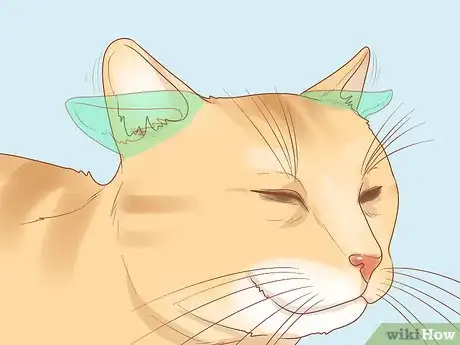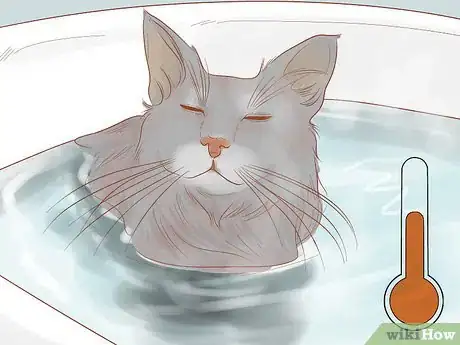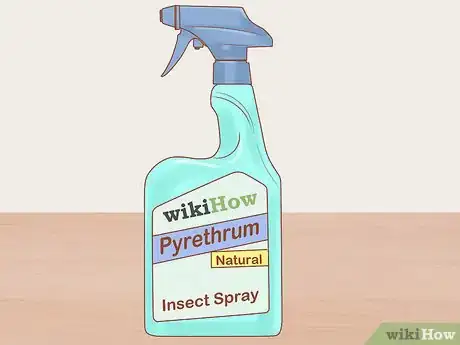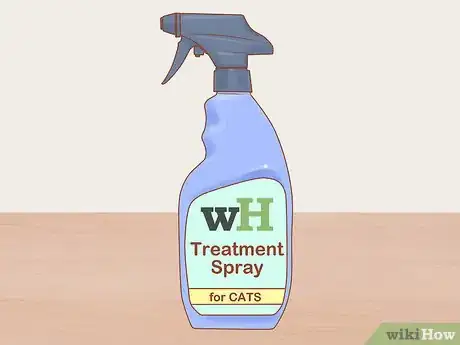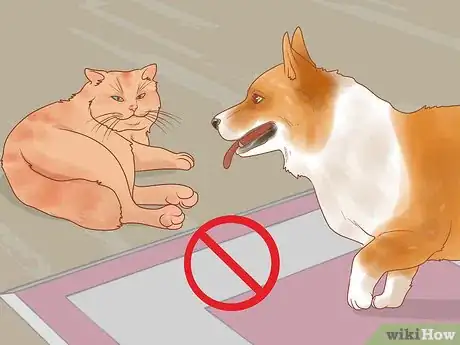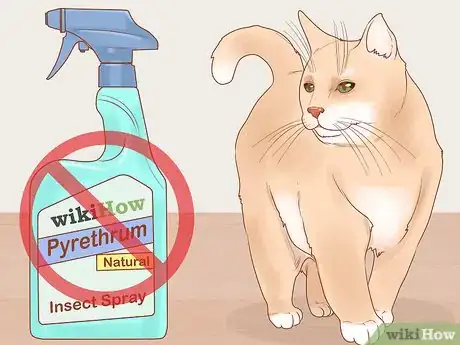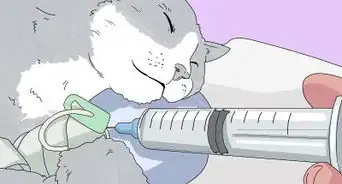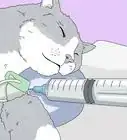This article was co-authored by Lauren Baker, DVM, PhD. Dr. Lauren Baker is a Veterinarian and Assistant Scientist at the University of Wisconsin-Madison. With over 10 years in veterinary medicine, she specializes in the concept of “one health,” which uses insights from veterinary medicine to help human medical research. She holds a Ph.D. in Comparative Biomedical Sciences, a Doctor of Veterinary Medicine, an MS in Comparative Biomedical Sciences, and a Bachelor’s degree in Psychology from the University of Wisconsin-Madison.
There are 7 references cited in this article, which can be found at the bottom of the page.
This article has been viewed 12,184 times.
Pyrethrin is a type of medication typically given to animals in order to treat infestation by fleas or ticks. Cats are especially sensitive to these drugs, and may experience serious ailments to their nervous system—up to and including death—if exposed to a strong dose of pyrethrin.[1] You can diagnose and treat this serious condition by looking for signs of muscle twitching or vomiting in your cat, and treat poisoning by rushing it to your veterinarian’s office. Strongly consider using parasite control that does not contain pyrethrin for cats, especially since there are many safer and effective options.
Steps
Diagnosing Pyrethrin Poisoning
-
1Watch for skin and ear twitching. If your cat has gotten too much of a pyrethrin-containing insecticide on its skin and is suffering from a relatively mild case of pyrethrin poisoning, it will exhibit signs of twitching or muscle contractions. Specifically, these will likely take the form of: cats flicking or twitching their ears, shaking or flicking their paws, or contracting the muscles along their abdomen.[2]
- Symptoms of pyrethrin poisoning typically begin to appear immediately after a cat has encountered the chemical. However, in some cases, symptoms can take up to 72 hours to emerge.
-
2See if the cat is drooling excessively or vomiting. If the cat has ingested pyrethrin, it will not exhibit twitching symptoms, but you may notice the cat drooling heavily (this is known as hypersalivation). Depending on the amount of pyrethrin the cat has ingested, it may also vomit several times. Cats who have ingested pyrethrin can also have symptoms of diarrhea.[3]
- It’s not uncommon for cats to have insecticide applied to their body or neck and, in the process of grooming themselves, ingest the pyrethrin.
- In these cases, cats may exhibit symptoms both of twitching and vomiting.
Advertisement -
3Watch for muscle tremors and seizures. In severe cases of pyrethrin poisoning, cats will exhibit uncontrollable bodily muscle tremors, which may turn into seizures. If left untreated or prolonged, these seizures can cause severe brain damage in your cat.[4] If you cat experiences a seizure as a symptom of pyrethrin poisoning, rush it to an animal hospital immediately.
Treating Pyrethrin Poisoning
-
1Rinse your cat with warm water. If your cat is suffering from pyrethrin poisoning, pick it up and carry it to a nearby sink or bathtub. Immediately begin running warm water into the basin, and place the cat under the stream so it gets thoroughly wet.[7]
- Since Pyrethrin can affect your cat more if its temperature drops, in early stages it is best to keep the cat warm.
-
2Wash your cat with grease-dissolving dish soap. Squirt some grease-dissolving dish soap onto your cat’s fur, and lather the cat with soap. Wash your cat’s fur and skin thoroughly, focusing most closely on the area where you applied the pyrethrin-containing insecticide.[8] Bathing your cat will remove some of the pyrethrin from its body and reduce the risk of death. Then, rinse the soap and towel your cat dry.
- A bath will only help your cat if it has had a dangerous amount of pyrethrin-containing insecticide applied to its skin.
- If your cat has ingested pyrethrin, and this is the cause of the pyrethrin poisoning, a bath will do no good.
- Do not bathe your cat if they are having tremors. Attempting to bathe a tremoring cat may make symptoms worse or trigger a seizure.
- Take a tremoring cat to a veterinarian immediately, so the tremors can be treated before decontamination via bathing.
-
3Take your cat to the veterinarian immediately. Once you’ve washed some of the insecticide off of your cat, take it to your veterinarian. They will be able to assess the extent of the neurological damage done to the cat. The vet will need to diagnose your cat, and will likely question you regarding when and if your cat had access to pyrethrin-containing insecticides. The vet will then recommend a course of treatment following the diagnosis.[9]
- In some cases, your veterinarian may advise to take your cat straight to an emergency animal hospital, rather than bring it to the vet first.
- If your cat experiences pyrethrin poisoning after hours or on a weekend or holiday, you’ll need to take it directly to an emergency animal hospital.
-
4Bring the insecticide packaging with you. To better assist your veterinarian in making their assessment and diagnosis of your cat’s pyrethrin poisoning, bring the box or bottle of insecticide medication with you. Without access to the medication and its packaging, your vet will not know the exact percentages of pyrethrin in the insecticide.[10]
- Also tell your vet all pertinent information about how the cat became poisoned.
Preventing Pyrethrin Poisoning
-
1Give your cat only cat-specific insecticide products. When looking for an insecticide to give your cat, make sure that you choose a medicine made for cats. if the medicine has been made for cats it will have a lower level of pyrethrins than a medicine designed for dogs, due to cats’ higher sensitivity to the pyrethrin. These medications will have low enough levels of the chemical that your cat will not risk being poisoned.
- There are many other options for flea control in cats that do not use pyrethrin.
- Some cats may still have a reaction even if the product is designed for cats. If possible, avoid the use of pyrethrin-based products for cats in general.
- Dogs have a naturally higher tolerance for pyrethrins, and so their insecticides tend to have much higher percentages of the chemical.
- Insecticides for dogs can contain from 45 to 60% pyrethrins, while products for cats contain less than 0.01%.[11]
-
2Ask your veterinarian if an insecticide is safe for cats. If you’re not sure whether or not an insecticide can safely be applied to your cat, ask your veterinarian. It would be wise to seek your vet’s recommendation for insecticides before you go shopping for them, to avoid potentially purchasing a pyrethrin-based product that is unsafe for your cat.[12]
- The sales staff at your local pet supply store may be able to help you as well.
-
3Do not let cats interact with dogs after pyrethrin-based products have been applied. Spot-on concentrated pyrethin-based products for dogs can remain on the dog’s skin and rub off onto the cat for up to 72 hours after application. If you apply the product to your dog, you should not allow your cat to interact with your dog for 3 days. If that is not possible, you will need to choose a different product for parasite control in your dog as well.
-
4Keep cats away from household pesticides. Because pyrethrin is so effective at killing all varieties of insects, it’s used in many organic pesticides. Check the informational label on any household pesticides that you may have. If they contain pyrethrins, be sure to shut them in a cabinet or cupboard that cats cannot access. Also avoid spraying these pesticides on indoor plants that cats have access to.[13]
- If you’ve sprayed outdoor plants with a pyrethrin-based insecticide, keep your cats from this area so they don't ingest the chemical.
- Pyrethrin can be found in many professional-grade insecticide sprays.
- If you’ve had a pest-control company spray your house to prevent insect infestation, contact the company and ask if their pesticide contains pyrethrins.
References
- ↑ http://www.petmd.com/cat/conditions/neurological/c_ct_pyrethrin_pyrethroid_toxicity
- ↑ https://icatcare.org/permethrin/vet-info
- ↑ https://icatcare.org/permethrin/vet-info
- ↑ http://www.cat-world.com.au/pyrethrin-a-pyrethroid-poisoning
- ↑ https://vcahospitals.com/know-your-pet/pyrethrinpyrethroid-poisoning-in-cats
- ↑ https://icatcare.org/permethrin/vet-info
- ↑ http://www.preventivevet.com/cats/lesser-known-pet-toxicities-pyrethrin-permethrin-toxicity-in-cats
- ↑ http://www.preventivevet.com/cats/lesser-known-pet-toxicities-pyrethrin-permethrin-toxicity-in-cats
- ↑ http://www.petmd.com/cat/conditions/neurological/c_ct_pyrethrin_pyrethroid_toxicity
- ↑ http://www.preventivevet.com/cats/lesser-known-pet-toxicities-pyrethrin-permethrin-toxicity-in-cats
- ↑ http://www.bellemeadanimalhospital.com/pyrethrin-and-permethrin-poisoning-in-cats/
- ↑ http://www.bellemeadanimalhospital.com/pyrethrin-and-permethrin-poisoning-in-cats/
- ↑ https://www.todayshomeowner.com/is-pyrethrum-a-safe-organic-pesticide/
- ↑ http://www.bellemeadanimalhospital.com/pyrethrin-and-permethrin-poisoning-in-cats/
- ↑ http://www.preventivevet.com/cats/lesser-known-pet-toxicities-pyrethrin-permethrin-toxicity-in-cats
About This Article
To diagnose Pyrethrin poisoning in your cat, watch for common symptoms including skin and ear twitching, excessive drooling, vomiting, and muscle tremors or seizures, which can be signs it ingested Pyrethrin. If you think your cat has been been poisoned, take it to the vet immediately for treatment. If your cat got into some Pyrethrin, but did not ingest it, you can take it to a sink or tub and wash it with grease-dissolving soap to remove the insecticide. To learn how to prevent Pyrethrin poisoning in the future, read more from our Veterinary co-author.
